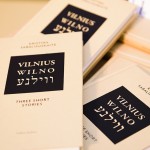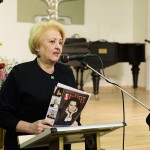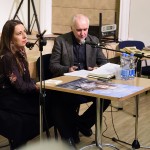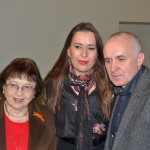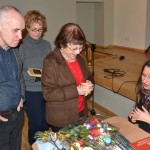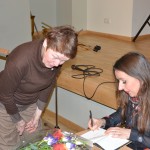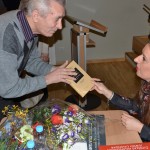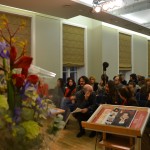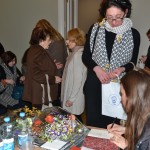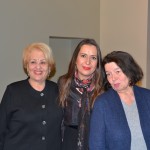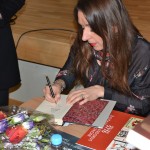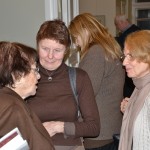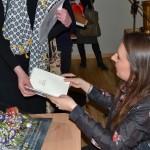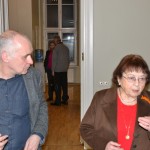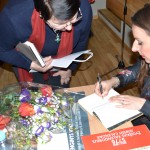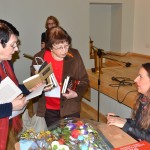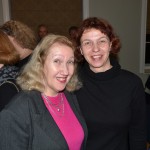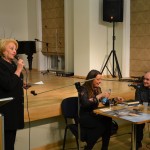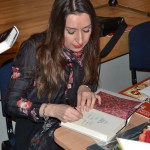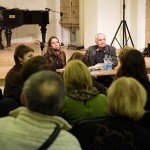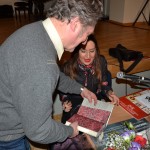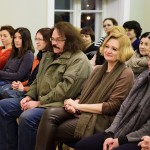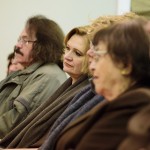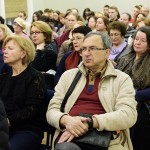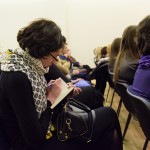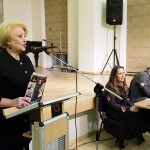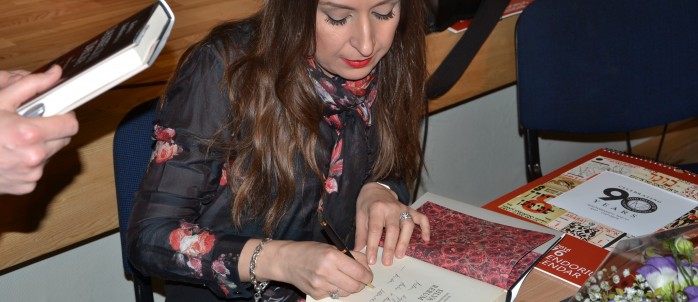
The 24th meeting in the Destinies series of seminars and lectures took place at the Lithuanian Jewish Community on February 17, called “Jewish Motifs in the Works of Writer and Art Historian Dr. Kristina Sabaliauskaitė. Teacher and essayist Vytautas Toleikis moderated the meeting and LJC deputy chairwoman Maša Grodnikienė, the organizer, served as MC and introduced Sabaliauskaitė in person to the audience, noting she was very popular outside of Lithuania as well in Poland and Latvia.
Moderator Toleikis addressed the full hall saying “Kristina has returned Lithuania’s historical memory. She brought back 200 years of history which, due to [historian] Šapoka’s paradigm were lost to Lithuanian consciousness. ‘Silva Rerum’ [‘Forest of Things’ trilogy by Kristina Sabaliauskaitė, 2008, 2011 and 2014] is for us an unexpected historical good fortune, as if the nation had won the lottery. We are lucky Kristina has brought back centuries of history. The author’s memory is not selective, she writes about everything in the past, about Poles and Jews as if they were her own people. This is the attitude of a 21st-century person, it could not be otherwise.”
The conversation during the Destinies meeting revolved around Jewish characters and how the figure of the Jew came to be included in Kristina Sabaliauskaitė’s works in a way very different from the more common portrayal found in Lithuanian literature. Sabaliauskaitė chose the elite person of the doctor Aaron Gordon.
Sabaliauskaitė:
The answer is simple: because I am from Vilnius. All normal residents of Vilnius grow up among Jewish and Polish children. When you play with the children in the yard, you don’t ask whether they are Polish, Russian or Jewish; either the child is nice and you play with him, or he’s naughty and you don’t want to have anything to do with him. It’s all very simple. Jews were never different to me, there was normal communication. To write about Vilnius excluding Jews is the same thing as not noticing the elephant in the room. Jews were also an organic part of the community, contributing and giving so much, that it’s impossible not to write about that part of the community.
The famous Jewish doctor—a Jew, a real historical person who came into ‘Silva Rerum’—Aaron Gordon didn’t appear accidentally. As an historian and art historian I was interested what Jewish history could tell us about the Grand Duchy of Lithuania. It was interesting there were so many elite Jewish doctors and that members of the [aristocratic] Radvila family gladly made use of their services. If Kristupas Radvila Perkūnas could entrust his life to Jewish doctor and famous cabbalist Solomon Del Medigo, that means he wasn’t afraid, the Jew wasn’t a stranger, even if he had come from afar he is a professional and intelligent, and may be trusted.
The Radvila [Radziwiłł] family and the Jews. The Radvilas in the history of the Grand Duchy of Lithuania are the closest thing we had to a royal dynasty and their connections with Jews were tight and full of trust. After being graduated from Padua University Aaron Gordon was the royal doctor to Jan Sobieski [king of Poland and grand duke of Lithuania]. In Vilnius doctor Aaron Gordon treated elite aristocratic patients. His lifetime coincided with a plague epidemic. I was interested to see how the city lived through the time of plague. The Jewish community in Vilnius at that time was rich and thriving. At the end of the 17th century university students organized a pogrom—a real historical event. It all happened because of a small matter. The students liked to play cards and borrowed from Jews, lost large sums and couldn’t pay them back. They attacked the living quarters of their creditors, smashed their windows and impotently sought revenge because they were insolvent. Young men from all over Lithuania who had lost money and were angry came and carried out probably the first pogrom described in documents.
There are 15 to 20 years of study, reading through a pile of sources, publications and research, behind all the facts described. As I wrote the book there was a ruthless rejection of historical facts in the name of good literature at the same time.
The third Silva Rerum book contains facts found at the library of Vilnius University. There survive testimonies from after the Vilnius fire, they’re printed at a printing press, and there is a rhymed text there saying the Jews are to blame for everything, that the fire started with them, although in fact there were three points of origin for the fire in the city, and only one was Jewish, the other two were Catholics. There was an interesting situation prevailing in Vilnius in the 18th century in connection with the Radvilas. They followed their own law in the city, and had large land holdings and governed them under their own laws without regard to the magistrate. All of Šnipiškės and the area surrounding St. George’s Church belong to the Radvilas, and Jews lived on these lands who made use of grand rights, because they only answered to the Radvilas, not to the magistrate or the guilds who were regulated by guild and magistrate laws. These circumstances allowed for much cheaper production and lower prices for all city residents, a specific economic matter. Jewelry made by the Jewish goldsmiths of Šnipiškės were a two-thirds or half the price of those from the city’s goldsmiths’ guild. They prospered and it was very profitable to the Radvilas as well because they received a cut, they collected taxes from their goldsmiths—one hand washed the other. Anti-Semitism had specific economic causes. Pamphlets and writings by city residents that the Jews were responsible for everything arose because they had more economic freedom. The real situation was intertwined with myths and legends and culminated in burning at the stake.
It was interesting for me to enter into and experience that worldview. On the one hand this community existed which held the favor of the Lithuanian nobility, although there were those among them who didn’t like them, such as Norvaiša. The Radvilas have financial and legal affairs with the community and communicate with Jews daily. The Norvaiša character at the beginning and end of the book, when the spirit of the Jewish girl Maya lives inside him, changes, he’s not the same person anymore. He goes down the path of knowledge, experiences the feeling of shame and undergoes metamorphosis by getting to know a Jewish family.
As I was writing I touched upon Judaism, although I didn’t dive into Kabbala because I knew it was better not to do that without being prepared, it might end badly. As I was writing the novel, I didn’t want to write on the sensational, fashionable esoteric, but I couldn’t brush it aside because it was very important and interesting to the people of the 18th century. The novel reflects that entire [spectrum of interest then]. One set of people are interested in the Kabbala as magical spells,— Jeronimas Florijonas Radvila—while Martynas Mikalojus Radvila has an entirely different kind of interest, that he adopted Judaism and converted, while, paradoxically, the Kabbala destroyed him as a corporal entity. He observed Sabbath and didn’t eat pork, only kosher food. One of the most interesting characters in the third Silva Rerum book, Martynas Mikalojus Radvila is called a possessed grand duke in Polish historiography. He was demonized in the 19th century, his family rejected him and he was pronounced of not sound mind legally. It was important to me to understand what was really going on there, and I began working with primary sources by his contemporaries. I came to understand he was a very interesting aristocrat and son of his epoch, the mid-18th century.
I spoke with the descendants of aristocrats of European countries who remembered their great-great-grandparents, and they began to squirm uncomfortably when they recalled the strange behavior of their relative from the Rococo [late Baroque] era. As the Catholic religion radicalized, there was the process of secularization as well, and aristocrats felt themselves immune from punishment and transgressed the usual and accustomed boundaries in all areas of life, constantly experimenting, wondering, what will happen? The Romantics of the 19th century couldn’t countenance this. Without the darkness there is no dawn. Jeronimas Florijonas Radvila was the bigger sadist because he had Martynas Mikalojus Radvila locked up, but his family didn’t condemn him because he hadn’t violated any conventions. Martynas Mikalojus Radvila ignored the strictures of society and wasn’t concerned with his own reputation. His enchantment with Judaism was a real mental affliction, I have collected all the available historical testimony about this person. He was erudite, a genius, an immeasurably educated man, a musical virtuoso. His delving into the Kabbala was a great scandal within the family and in society. Though they wanted to, the Radvila family couldn’t cross Martynas Mikalojus off their list of family members, but for 300 years they didn’t utter the name Martynas in public.
A researcher has to check facts and accept nothing at face value, to doubt everything. Where doubt ends and acceptance of the existing begins, that’s where science ends and ideology begins.
How did a real living man appear in the story “The Return of the Vilner?” I reply: every self-respecting Lithuanian has his own Jew. In him mingle personal knowledge, historical facts and literary imagination. When the Vilner leaves the courtyard where the Jewish synagogue once stood and now there is a kindergarten and sees the graffiti “Juden raus,” he says: “What Juden raus? Where do you see any Jews here? There’s not a single one here.” He’s right, because so very few Jews are left.
I wasn’t afraid to portray xenophobes. When my character Philomena, who considers herself an anglophile, has read all about England and loves Agatha Christy, travels to London, she discovers a very different England. This is a story about cultural stereotypes. Philomena runs into her god David Suchet in a restaurant doorway, who’s not an Englishman but a Belgian, but later she learns David Suchet—Hercule Poirot—is actually a Jew from Kretinga [sic, Suchet’s grandfather was from Kretinga near Memel/Klaipėda but his father Jack was born in Johannesburg and David Suchet was born in London]. This is a great shock to her. This sort of everyday anti-Semitism is an interesting thing. Hand me a text and I’ll tell you about the person who wrote it. Listening to speech you pick up on anti-Semitism. What does it mean when someone says in public speech, “person of Jewish ethnicity?” It horrifies me. After all we don’t say of English or Ukrainian or of Lithuanian ethnicity. It’s a disgusting sign of separation which arises out of ignorance. I will be happy when these everyday subconscious things disappear from our speech because that will show we are healing, and anti-Semitism is craziness.
History and certain chapters which have not been considered sufficiently can bleed and become topical, and we need to talk about them as openly and as scientifically as possible. If we don’t think about history we will never understand the errors of the past. We won’t be able to understand who we are and we won’t be able to plan for the future. Throughout 20th century Lithuanian literature it’s as if we have been picking raisins out of the pie and throwing out all other ethnicities.
Europe 10 years ago and Europe today are very different. Ten years ago we lived in conditions of relative peace, now we are in the center of the whirlwind, there is a battle for the future of the identity of the old and experienced civilization of Europe against a young and very aggressive ruthless force and the time has come to defend radically our European values. People often ask me about Lithuanian identity and being true to Lithuania. Nazis marching on March 11 with Posts of Gediminas and xenophobic chants are not Lithuania nor a nation, but Lithuania’s shame, a denigration of the historical commonwealth of the different nations constituting Lithuania and a sickening echo of the distant shooting of Jews. The relatively recently created ethnolinguistic isolation and rejection of great swathes of the history of Lithuania in place of dialogue and understanding is also unacceptable to me. For me Lithuanian identity is not about rejection, it’s about uniting in the search for spiritually enriching Lithuanian connections. Historically it’s always multiethnic, tolerant, mixed, giving rise to many things. That’s the Lithuania to which I am true.


